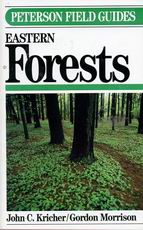

|
|

A Field Guide to Eastern Forests
Kricher, John C.; Morrison, Gordon
Publisher: Peterson Field GuidesYear Published: 1988 Pages: 368pp Price: $14.95 ISBN: 0-395-47953-3 Library of Congress Number: QH102.K75 1988 Dewey: 574.5'2642'0974 Resource Type: Book A "second-generation" field guide to the ecology of the forests and fields of eastern North America. Abstract: - Table of Contents: Editor's Note Preface Acknowledgements 1. How to Use This book The Search for Patterns Fields and Forests Area Covered General Organization The Seasonal Approach Getting Started 2. Forest Field Marks Seeking patterns Stratification Types of Trees Indicator Species Species Richness Soil Characteristics Soil Moisture and Habitat Evidence of Fire Plant Population Patterns A Forest's Age forest Gaps Predicting a Forest's Future Ecotones Old Fields Animals of the Forest Insects and other Arthropods Birds Mammals reptiles and Amphibians The Forest food Chain and Ecological Pyramid Plant and Animal Identification Getting Started - A Forest field-mark Questionnaire 3. Eastern Forest Communities Communities of Plants and Animals What Determines a Community? Eastern Forest communities Boreal Forest Boreal Bog jack Pine Forest Eastern Deciduous Forest Communities Northern hardwood forest New England Alpine Community beech-Maple Forest Maple-Basswood Forest Oak-Hickory forest Northern Riverine (Floodplain) Forest Northern Swamp Forest Northern Pine-Oak Forest Southern Mixed Pine-Oak Forest White-cedar Swamp Forest Mixed Appalachian Forest Communities Appalachian Cove Forest Appalachian Heath Balds Southern Hardwood Forest Southern Riverine Forest Baldcypress Swamp Forest Southern Mixed Hardwood Swamp Forest Subtropical Forest mangrove Swamp Forest Everglades Texas Savanna Prairie Northern Savanna 4. Disturbance and Pioneer Plants What Is Disturbance? What Causes Disturbance? Ecological Succession: the Process of Vegetation Development Over time Old Field Succession Early Old Fields Other Field Marks of Vegetation Disturbance and Change Old Filed Succession - A Detailed Look Shrubs Along Power Lines Riverine Zonation Vegetation Development Without a Soil Base Sand Dune Zonation Rocky Outcrops Landscape Patches, Forest Fragmentation Birds of Old Fields, Edges, and Forest Interior 5. Adaptation The Woodchuck - Hibernation and Adaptation bird Migration Insectivorous Plants Plant Defenses Why Are Leaves Green? Why isn't All Bark Alike? Why do some Spider Webs Have Thick Zigzag Strands? How Adaptation Occurs - Natural Selection 6. Patterns of Spring Flower Structure and Pollination Stream Habitats and Animals Convergence Amphibian Patterns Bird Patterns Mammals - Dispersal and Road Kills 7. Nature in Summer Tree Geometry, Leaf Size, and Leaf Angle Habitat and Growth Form in Plants Patterns of Fruiting and Seed Dispersal Milkweed Ecology patterns of Insect or Spider Camouflage and Mimicry Leaf Rollers, Folders, Tiers, and Miners gall-makers Dragonfly mating Patterns Defense Adaptations of Snake and Other Reptiles Patterns of Bird Nesting 8. Autumn and Winter Soil Natural History Fungi Litter and Soil Animals The Litter-Soil food Web leaf color Changes Anatomy of a Twig Tree Trunks and Growth Rings Masting Mixed foraging Flocks Irruptions of Bird Species Winter Rangers of the Northern Junco Winter Adaptations of Birds Vole Cycles List of Common and Scientific Names Index Subject Headings |